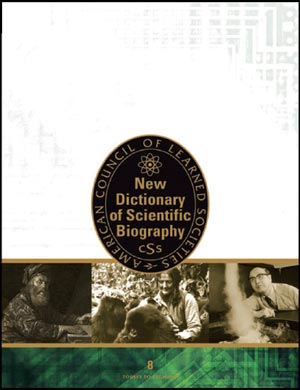A reference work that changed the history of science has now been brought into the 21st century with new entries and an online version, says Robert P Crease

Its progenitor once described the New Dictionary of Scientific Biography — or DSB, as it is known to historians — as a “gothic cathedral”. The analogy is apt: this vast 18-volume reference work is a landmark collaboration, painstakingly crafted by experts, the scope and influence of which have grown over time.
The first volume of the DSB appeared in 1970 and it became the most important reference work in history of science, with over 5000 biographies from Thales to Einstein. Due to the huge amounts of time and money needed to prepare it — plus the impact of the Web as an information resource, or what might be called “wiki-influence” — the DSB is likely, and regrettably, the last great published reference work containing entries, composed by leading scholars, that are mainly works of scholarship themselves.
Like a cathedral, too, the DSB is open to change by future generations; last month it was substantially updated for the first time with the publication of eight new volumes largely dedicated to scientists who have died since the original came out. A searchable electronic version is now also available.
Birth of an idea
The DSB was the brainchild of Charles Scribner Jr, who died in 1995 at the age of 74. (The Scribner family includes over a half-dozen generations of Charles Scribners, but to avoid sounding monarchical they recycle the Jr.) Scribner graduated from Princeton University in 1943 in classics, but often found scientists more stimulating than novelists. Once, while at Princeton, he was offered the choice of lunch with Albert Einstein or Thomas Mann and chose the latter — a decision he soon regretted, finding the novelist “pretentious and deadly boring”.
A code-breaker during the Second World War, Scribner entered the family publishing business and became president of Charles Scribner’s Sons in 1952. However, he continued to take an interest in history of science, and was a particular fan of Newton and Einstein; indeed, he owned a red velvet-covered chair from Newton’s sitting room. Once, reading Einstein’s 1905 article on special relativity, Scribner noted it had been wrongly rendered into English and in 1963 published a correction in the American Journal of Physics (Am. J. Phys. 31 398), demonstrating instincts that would make him an excellent encyclopedia editor.
Scribner loathed the trendy authors chased by other publishers, and instead cultivated scientist-writers such as C P Snow. In 1963, longing to create a work of intellectual durability, he approached Princeton historian Charles Gillispie to discuss the idea of a “dictionary of scientific biography”. It would be a scientific analogue of the Dictionary of American Biography, which itself had been created by Scribner’s grandfather as a US version of the British Dictionary of National Biography.
Gillispie, president of the History of Science Society, realized that such a work could make history of science more collective and scholarly, boost the interaction and morale of its small band of scattered practitioners, and attract attention to the field. The National Science Foundation covered the editorial costs, Scribner’s paid for the publishing, while the American Council of Learned Societies oversaw the editorial effort.
Who’s in and who’s out
To Scribner’s consternation, a clerical error led to Newton’s omission from the initial entry list. Non-Western science was another problem. Chinese scholars then were not communicating with the West — but thanks to the ongoing publication of Joseph Needham’s monumental, multivolume work Science and Civilization in China, the editors did not need to cover that area. A supplement to the DSB includes essays on science in India, Mesopotamia, Egypt, Japan and the Mayan civilization.
Then there were the Soviets. Gillispie collaborated with A P Youschkevitch, the foremost scholar in the Institute of History of Science of the Soviet Academy of Sciences. However, Soviet apparatchiks insisted on certain strings as a condition of participation, including obligatory entries on Marx, Engels and Lenin. Gillispie agreed, but wrung the concession that these entries would be subject to the same editorial standards of accuracy as the others.
The editorial board defined its approach — focusing on people not subject matter — by saying that “history of science like other aspects of history is made by men and not by themes or abstractions”. The project grew beyond all expectations: there were initially meant to be just four volumes, not 16. (Two supplements were also published in 1990.) The index alone, published in 1980, cost over $100 000 to produce, and managing editor Marshall de Bruhl wrote that it may be “the last large, complete, topical index produced for a major reference work by a commercial publishing house”.
The eight new volumes, edited by Indiana University philosopher and historian of science Noretta Koertge, appeared last month both in print and — together with the original — online (http://gale.cengage.com/ndsb). They contain about 800 new articles: 600 new entries and 200 updates. Physicists who appear for the first time include Hans Bethe, Richard Feynman, Andrei Sakharov, Edward Teller and accelerator physicist M Stanley Livingston (whose entry I wrote).
The critical point
A historian of science once wrote, concerning certain biographical questions in the life of Ernest Rutherford, that “none of these things really matter”. They do not — in the traditional, topic-oriented approach to history of science. But biographies do bring to light aspects of science that are otherwise hidden. They show that science history is more than puzzles and solutions. They reveal the intimacy of creation — why specific individuals were pulled to certain problems, and how these individuals brought to bear their culturally and historically shaped imaginations to solve them.
The DSB has helped to demonstrate the value of this knowledge. It is therefore a testament not only to scientists, but also to the historians who created it.



